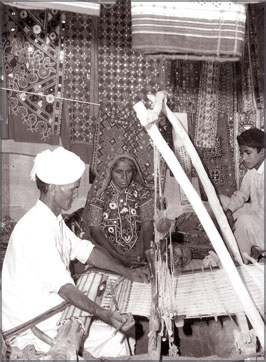Hand-spun tradition
The traditional hand-spun and hand-woven textiles are probably the
oldest, as is apparent from the finds of fragment of finely woven cotton
fabric at Moenjodaro (mounds of dead), from the Indus valley
civilisation five thousand years ago.
This cotton fragment, found at Moenjodaro, has sixty ends and twenty
picks per inch and is made of 34 counts thread. It was because of this
degree of refinement that cotton cloth was described by terms derived
from Sindh, Sindhu and Sindhian.

According to Herodotus, Sindhian cloth was widely used in Egypt and
the Mediterranean region around 500 BC. Extremely fine muslins from
Sindh were used to wrap mummies in Egypt and were worn by Roman Emperors
from Agustus to Hadrian.
A ninth century Arab traveller, Suleman Tajir, observed "the cotton
cloth of this country is so fine that it can easily pass through a
finger ring. Nowhere in all the world is finer cloth made than in this
country."
During Muslim rule, the traditional techniques continued with new
technological developments and new motifs. During the two-and-a-half
centuries of relative peace and stability, the Moghals established a
highly industrialised empire. Cotton textiles were the main products of
trade and export.
The Moghals not only patronised the imperial workshops, finest silk
and woollen carpets for their own use but also encouraged the
development of a country-wide carpet industry.
Among the varieties of cloth mentioned by the British traders are 'bafta',
chint, malmal, sussi, gharbi, tusser, ajrak, lungi, khes and chunni.

Despite Sindh, other regions of Pakistan are also famous for their
textile crafts. Woollen fabrics of Frontier and Punjab were exported to
Syria and Egypt in the early decade of the Christian era.
Lahore grew into a leading centre of textile production during Moghal
era. Abul Fazal has mentioned that because of Akbar's interest a
workshop of weavers was established in Lahore to promote the production
of Silks, Brocade and Velvet.
The textile crafts suffered during the British rule in subcontinent
because of their economic strategy. Despite physical punishment the
hardy rural folk kept the native textile tradition alive. However, most
of the weavers now depend on machine-spinning.
Mill-made yarn in different counts is available to all categories of
weavers, yet, the charkha has not gone out of use altogether nor has the
spindle become obsolete.
A greater part of Pakistan's handloom cloth is made from indigenous
cotton which remains a major cash crop of the country.
The simplest cotton weave 'Khaddar' described generally as coarse
cloth is still in vogue. Although 'Khaddar' is produced all over the
country yet the finest qualities are woven in Peshawar in Frontier
Province; Lahore, Multan, Jhang, Sargodha, Kasur, Kamalia and Khelum
districts in the Punjab; Thatta, Mirpurkhas and Karachi in Sindh.
Despite routine Shalwar/Kurta, Khaddar is also produced to meet the
household requirements, such as-bed-covers, cushion covers, table
cloths, plate-mats and curtains. During Moghal era this kind of textile
was promoted to a higher degree and it became an important item of
export.
At present Khes are used throughout Pakistan as bed covers, curtains,
table covers, floor covering and shawls. Although simpler varieties are
produced throughout Punjab and Sindh, the best known Khes comes from
Multan, Sargodha, Gambat and Nasarpur.
Although the weaving techniques and constructions are similar in
Sindh and Punjab but the colour schemes and designs vary on account of
the taste and traditions of these areas. The Khes are traditionally
woven in pairs.
The most common draped clothing is known as 'lacha' in interior
Punjab. The image of a Punjabi village is not complete without 'Tehmud.'
The most colourful 'tehmud' is known as 'Lungi' produced on handlooms in
a number of towns - Multan, Faisalabad, Jhang, Sargodha, Kasur and Pind
Dadan Khan in the Punjab.
Embroidery is a common trait for Pakistani womenfolk and admired by
tourists from all over the world. A great diversity of embroidery styles
can be found in different regions of the country.
The thin bronze needles discovered from Moenjodaro resemble those
used for embroidery. During the Moghal period embroideries were listed
among the crafts manufactured for export.
Lavish gold and silver embroideries on silk and velvet were in vogue
during the Moghal era and has over the years been popular, and still
continues to be a leader attraction even in the tourist industry. |
